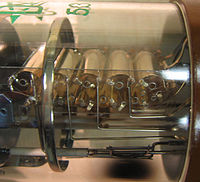
Photo from wikipedia
Amplified spontaneous emission (ASE) threshold in CsPbBr3 quantum dot films is systematically reduced by introducing high quality TiO2 compact layer grown by atomic-layer deposition. Uniform and pinhole-free TiO2 films of… Click to show full abstract
Amplified spontaneous emission (ASE) threshold in CsPbBr3 quantum dot films is systematically reduced by introducing high quality TiO2 compact layer grown by atomic-layer deposition. Uniform and pinhole-free TiO2 films of thickness 10, 20 and 50 nm are used as a substrates for CsPbBr3 quantum dot films to enhance amplified spontaneous emission performance. The reduction is attributed indirectly to the improved morphology of TiO2 compact layer and subsequently CsPbBr3 active layer as grown on better quality substrates. This is quantified by the reduced roughness of the obtained films to less than 5 nm with 50 nm TiO2 substrate. Considering the used growth method for the quantum dot film, the improved substrate morphology maintains better the structure of the used quantum dots in the precursor solution. This results in better absorption and hence lower threshold of ASE. Besides that, the improved film quality results further in reducing light scattering and hence additional slight optical enhancement. The work demonstrates a potential venue to reduce the amplified spontaneous emission threshold of quantum dot films and therefore enhanced their optical performance.
Journal Title: Nanomaterials
Year Published: 2020
Link to full text (if available)
Share on Social Media: Sign Up to like & get
recommendations!